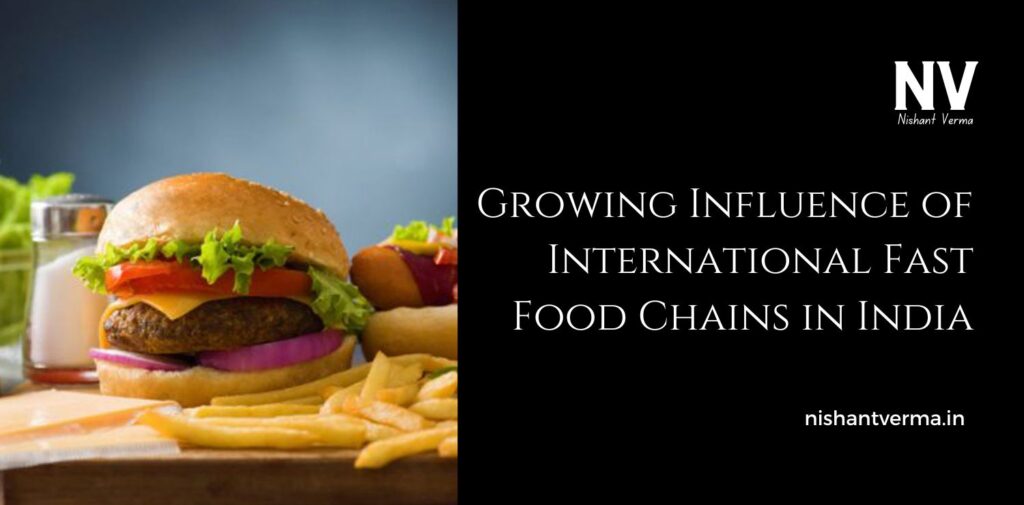In recent years, there has been a big change in the food habits of people all around the world, and India is no exception. People in India are eating more fast food than ever before, especially food from international fast food chains. These global brands, like McDonald’s, KFC, Pizza Hut, and Subway, have become popular in India, and today, they are found in cities and towns across the country.
But how did this happen? Why are these fast food chains becoming so popular in India, and what impact do they have on Indian food culture? In this article, we will explore the growing influence of international fast food chains in India, and how they have changed the way we eat and think about food.
The Rise of Fast Food in India
India has a long tradition of diverse and delicious food, with each region offering its own unique flavors. For centuries, people in India have enjoyed homemade meals, street food, and local dishes. However, things started to change in the 1990s when international fast food chains began to enter the Indian market.
The first major international fast food chain to open in India was McDonald’s. It opened its first restaurant in New Delhi in 1996. This was a big step, as it introduced Indians to a completely new kind of food – burgers, fries, and soft drinks. McDonald’s wasn’t the only chain to enter India; soon, other brands like KFC, Pizza Hut, and Domino’s followed, each bringing their own menu of fast food.

Why Are International Fast Food Chains So Popular in India?
There are several reasons why these fast food chains became so popular in India. Let’s take a closer look:
- Convenience and Speed: One of the main reasons fast food chains became so popular is because they are quick and convenient. People are often busy with work, school, or other activities, and they don’t have a lot of time to cook meals at home. Fast food chains offer food that is ready in just a few minutes, so people can grab a meal on the go without waiting for a long time. Whether it’s a burger, pizza, or a fried chicken meal, international fast food chains serve food that is quick, easy to eat, and ready in no time. This convenience makes them an attractive option for busy people.
- Globalization and Changing Lifestyles: India has become more connected with the rest of the world, especially in the last few decades. With the rise of the internet and social media, people in India have been exposed to new cultures and lifestyles. International fast food brands have become a part of this globalized world. People in India, especially young people, have started to embrace the lifestyle of fast food culture. As cities grew, more and more people started living busy lives, with fewer hours spent cooking at home. Fast food became a modern and trendy way to enjoy meals, especially among the younger generation.
- Taste and Variety: International fast food chains offer a wide variety of food, much of which is different from traditional Indian dishes. For example, burgers, pizzas, fried chicken, and French fries are foods that many people in India were not used to eating regularly before these brands came to India. These fast food chains have also made changes to their menus to suit Indian tastes. For example, McDonald’s introduced a vegetarian burger, like the Aloo Tikki burger, to cater to the large number of vegetarians in India. Similarly, KFC introduced spicier options to appeal to Indian taste buds. The fact that these brands offer food that tastes good and is familiar to international tastes has played a big role in their success in India.
- Advertising and Marketing: International fast food chains are also known for their smart advertising and marketing strategies. They use television ads, social media, and catchy slogans to promote their food. Advertisements often show happy families and friends enjoying a meal together, which makes the food seem fun and exciting. These brands also promote special offers, like discounts or “buy one, get one free” deals, which attract people to visit their restaurants more often. With the help of these clever advertisements, these fast food chains have built a strong brand image and become a part of popular culture in India.
- Urbanization and Western Influence: As India’s cities have grown, there has been a rise in urbanization, meaning more people are living in cities and working in offices. In these urban areas, fast food is often seen as a symbol of modernity and a lifestyle that is more aligned with global trends. Many young Indians are influenced by Western culture, including the way people eat in countries like the United States, where fast food is very popular. For many young people in India, eating at international fast food chains is seen as a way to be part of this global, modern lifestyle.

The Impact of International Fast Food Chains on Indian Food Culture
While international fast food chains have brought many benefits, such as providing quick meals and offering variety, they have also had an impact on Indian food culture. Let’s look at some of the effects:
- Changing Eating Habits: With the rise of fast food, many people, especially younger generations, have started eating out more often instead of cooking at home. Fast food chains have made it easier to grab a quick bite, leading to a shift in eating habits. Many people now prefer the convenience of fast food instead of spending time cooking traditional home-cooked meals. This shift in eating habits has led to a decline in some traditional Indian cooking methods and recipes, as people opt for ready-made, fast food options.
- Health Concerns: One of the main concerns about fast food is its impact on health. Fast food is often high in fat, salt, and sugar, and consuming it regularly can lead to health problems like obesity, heart disease, and diabetes. As more people eat fast food, there is a growing concern about the rising rates of lifestyle diseases in India. In response to these health concerns, some fast food chains have started offering healthier options, like salads and low-fat items. However, eating fast food too often can still have negative effects on health.
- Competition with Local Food: As international fast food chains become more popular, they sometimes compete with local restaurants and street food vendors. India has a rich tradition of street food and local snacks, like pani puri, samosas, and chaats, which are loved by many. Fast food chains have introduced a different kind of food culture that sometimes takes away from the popularity of these traditional snacks. However, many local food vendors have also started offering fast food items like burgers and fries, blending local food culture with global trends.
- Economic Impact: International fast food chains have created jobs and contributed to the Indian economy. They have opened thousands of restaurants across the country, providing employment to millions of people. From restaurant staff to delivery drivers, these brands have played a part in offering jobs, especially in urban areas. However, some people argue that these global brands, which often operate on large-scale models, can hurt smaller, local food businesses. Many local street food vendors and small restaurants face tough competition from these big chains.
Conclusion
The growing influence of international fast food chains in India shows how much the country’s food culture has changed in recent decades. These fast food brands have become a part of urban life in India, offering quick, tasty, and affordable meals. They have changed the way people eat, especially in cities, and have influenced the lifestyle of young people.
However, this shift towards fast food also brings challenges, such as health concerns and competition with local food traditions. It’s important for people to find a balance between enjoying fast food and preserving India’s rich food culture.
As time goes on, international fast food chains will continue to play a role in shaping India’s food landscape, but they will also need to adapt to the country’s unique tastes and traditions to stay relevant. Whether it’s through healthier menu options or respecting local flavors, these brands will continue to influence food culture in India for years to come.




